Gardening for wildlife
(Contd from last month)
The Butterfly Diaries
Fortunately, I have never found, horror of horrors, the arch-villain, in my shoes or garden - the saw-scaled viper. I'm sure he must be there for my garden is fenced with old duck-boards standing upright, but I never saw him. Nearby yes, but never in my garden.
But lets put these night-time experiences away, for the sun has peeped over the dunes. At this time, strangely, it is not the birds that draw you but the bees. For my garden boasted two hives of bees. They appeared almost together one year after the winter
had passed. The largest was in the tree and belonged to Apis florea, Dwarf Honey Bee. The second hive in the thatch of my garden fence behind a bamboo 'patti' screen was the hive of Apis cerana, the Asiatic honeybee. For a brief period these hives flourished,
each oblivious of the other, and just as suddenly died out in the autumn. But while they were there, the humming of bees around the sunlit portulacas gave an almost-ethereal feeling to me drowsing in my plastic garden-chair under the tree.
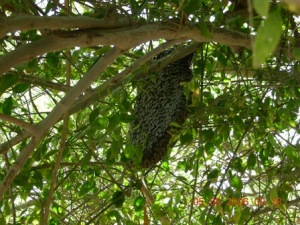
The hive in the tree! (Apis florea)
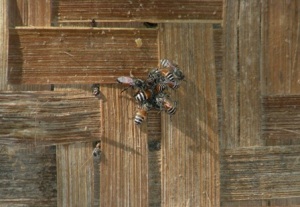
The hive in the thatch. (Apis cerana)
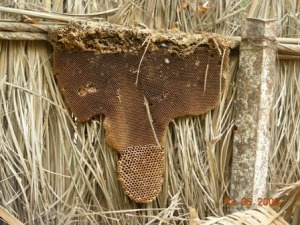
The abandoned thatch hive exposed. Never imagined it to be so large!
The authorities pipe water twice a day, once in the early morning and once after dark. So in between these times, you are dependent on water in the roof tanks and stored water in the bathroom buckets. Water is life in the deserts. The pipeline supplying the
garden has a small leak at the place where it bends around the garden corner and there it leaks. Each morning, the garden creatures are treated for an hour or so to a thin lamellar flow across a patch of cemented pavement. I have forbidden its repair so that
the creatures can get their small but just desserts!
The bees buzz here across the garden from the hive , and like teenagers wearing many pocketed jeans, they pick up water in the small cups or satchels on their legs and take off for the hive. I imagine this water is used to keep the queen and the larvae air-conditioned
through the summer. The bees drink greedily of this water and long after it has stopped they crowd the fence, pipe, wet gravel and moist soil with an unquenchable appetite.
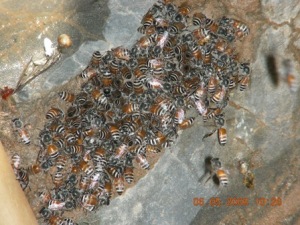
Its not just humans who store water each day!
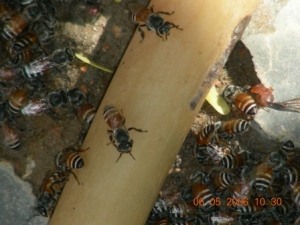
The bees crawl everywhere to get at the water. (Apis cerana)
Seeing this and the fact that their presence kept some small creatures away I added two more sources of water. A pot of water hung from a tree branch for the birds and bees and a earthen water-bowl for the squirrels, jirds and other creatures at ground level.
Since I was watering them, I decided to feed them, so I added a small wooden feeding tray. The carpenter was so gratified at being asked to do so noble a task that of his own he added a bird-house to the tray. I did'nt have the heart to put him right but gave
him an extra shabash! Anyway, the bees now started raiding the water-pot in the mid-morning and afternoons too!
-(To be continued)
|